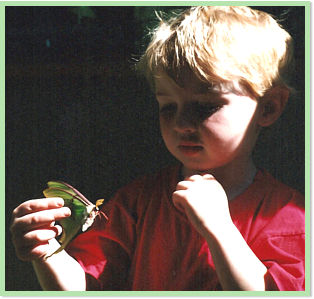
Silk Moths in the Classroom
| By Doug Collicutt | (Click links for more images.) |

A Luna moth to set free.
The emergence of a giant silk moth from its cocoon is one of nature's great shows. Witnessing this miraculous event is not as difficult as you might think. With some foreknowledge and a little good fortune, "silk moths in the classroom" makes an easy and memorable demonstration of insect metamorphosis.
The key to having silk moths emerge from cocoons in the classroom in May or June is getting hold of some caterpillars in August of the previous year. This is not as difficult as you might think. Polyphemus and Luna moths are very common throughout southern and central Manitoba, but there are really only two periods in the year when you can find them. Once is during the late spring emergence of the adults as winged moths. The other is when, as caterpillars in mid-late August, they go "walkies", looking for places to cocoon. The rest of the year they are largely unseen as small green caterpillars on trees or shrubs or as pupae in camouflaged cocoons.
Wherever there are forests of deciduous trees, including in cities, there could be Polyphemus or Lunas (our other two silk moths have much spottier distributions). If you want to find caterpillars, just make a habit of going for walks along trails or roads in forested areas in mid to late August, and keep your eyes on the ground. The large, bright green, thumb-sized caterpillars are not difficult to spot when they venture out to cross the open ground. Always take some sort of container with you on your walks. Sooner or later you will find a caterpillar of some sort. Caterpillars of all sorts "go walkies" when they have reached full size, so you may encounter a number of different kinds. (Follow this link for the Biology of Giant Silk Moths.)
Size alone, up to 10 cm lg and 1.5 cm wide, is usually enough to distinguish silk moth caterpillars from all others. Only the sphinx moths (Family Sphingidae) have species whose caterpillars approach the size of silk moth caterpillars and all of the sphinx caterpillars have curved horns on their tails. (The cocoons or pupae of any moth species will provide you with a wonderful classroom demonstration, but there are varying techniques required for successfully rearing and overwintering the different species. We hope to provide more information on this topic in the future.)
A fully grown Luna caterpillar
When you find a caterpillar, place it into your container and keep on walking. May as well enjoy the walk, right? And where there's one, there's bound to be more. Go ahead, be a little greedy, get more than one! It's extremely unlikely that you will be able to wipe out the population of silk moths from your woods by taking the few that happen to be crossing the trail as you walk by. Throughout August, be sure to keep some sort of container with you. You never know where one might pop up. And tell people you know to be on the look-out for caterpillars, the more eyes the better!
When you get your prize home, or back to the classroom if you're teaching summer school, you'll need to find a suitable container to serve as a home for the caterpillar and its cocoon for the next nine months. A small, 1/4 L jar or margarine container is fine. Make a few small holes in the lid and place a few twigs inside, preferably some with a leaf or two attached. They don't need any more food, the leaves are to incorporate into the cocoon. Place the caterpillar (one to a container is best) inside and close the lid properly. They are quite strong and can force open a loose lid and crawl off! Keep the container in a cool, dry location. The caterpillar may continue to march aimlessly around the container for a couple of days, perhaps unsatisfied with its surroundings, but sooner or later it will accept its lot and settle down to make a cocoon.
Once it has begun to cocoon, you can remove the lid and watch the activity more closely if you desire. Completing the cocoon will take a day or two. After this the caterpillar will ready itself for its transformation to the pupal stage. This usually occurs a few days after the cocoon is complete. Now, all you have to do is find somewhere to leave the cocoon until next spring. It's actually a good idea to loosen the cocoon from the sides of the container if the caterpillar happened to attach it there. Once the cocoon has hardened it is safe to handle it, even to allow people or students to touch it, gently. In the spring you will be placing the cocoon into a larger container, so loosening it now saves doing it later and lets you put several cocoons into one small container that can be put away securely for the winter. The cocoons should be stored outdoors, where they will experience the natural temperature regime. An unheated garage or shed is fine, just don't place them in a window where the sun would heat them. And make sure they are safe from mice or other small mammals! They would be a tasty treat for a squirrel or other rodent! The final thing to do is to leave yourself a note, as a reminder that you have the cocoons and where to find them! Nine months is a long time.
|
A Columbia silk moth spinning its cocoon
In late April or early May of the following year it's time to bring the cocoons into the classroom. (Hopefully, you will remember that you have some cocoons and where you left them!) You will need a fairly large container to place them in, at least shoe-box-sized. Make sure that the adult moths have ample room to expand their wings and even to flutter around a bit. A shoe box stood on end with screen covering the open top is a suitable container. It's important that you can see into the container. After all, the whole idea is to see the moth. It's also important to have some surface that the moth can easily climb. Moths like to hang, at least from a vertical surface, to inflate and dry their wings. If they emerge from the cocoon and cannot find something to climb on, their wings will not form properly! One or two small sticks leaning upright will suffice.
What are the chances of students actually seeing the moth emerge from the cocoon? Actually, quite good. Provided your pupa has made it through the winter alive - and this is not a certainty no matter how well you've cared for it - you could expect to see the moth emerge sometime after early May and certainly before late June. One sure way to tell if your pupa is still alive is to jostle it slightly. A live pupa will usually wiggle inside the cocoon at this disturbance. Since silk moths usually emerge during mid-morning, chances are 5 out of 7 that you'll get to witness the event. Make a habit of checking on the cocoon regularly. Have it sitting in a prominent place.
If you are fortunate enough to witness the actual emergence, take the time to enjoy it. It will only be about half and hour from the time the moth struggles free with its wings all crumpled up until it is resting quietly with its wings fully expanded and drying. The final stages of this year-long metamorphosis are worth watching.
Now what? You have an adult silk moth in a box in your classroom. What do you do with it? Well, first of all, don't be in too great a hurry to do anything with it. Look at it and enjoy it. If your moth has emerged mid-morning it won't be ready to fly until late afternoon at the earliest. Time enough to arrange for other classes to see the moth or to prepare for a "release ceremony". But there's no real hurry. The moth can survive quite well in its box for several days. Remember, it has no mouth parts for feeding or drinking. Its sole purpose is to find a mate and reproduce. And that's probably what you should let it try and do. The ideal way to release your silk moth is to take the box or container outside, open it and place it somewhere it will be safe until evening. The moth will simply fly away on its own once darkness sets in.
|
Should you worry about releasing a moth far from where you found the caterpillar? That, of course, depends on how far away you found the caterpillar and whether or not there is proper moth habitat around your release site. If you brought a Columbia silk moth caterpillar from a tamarack forest in eastern Manitoba to a classroom in Winnipeg, it makes little sense to release it in Winnipeg. And it may be impractical for you to return it to its natural habitat. For our other three silk moth species this is less of a concern, as their habitat is common throughout southern and central Manitoba. Use your own best judgment as to "where" or whether or not "to" release your moth. (Remember, there are ethical considerations you should make before embarking on any "critters in the classroom" project.) Preserving specimens for further observation or study is still a valid thing to do. Moths can be painlessly euthanized by carefully placing them in an envelope and putting this into a freezer.
Seeing a large silk moth flying is something that few people get a chance at. If you want to give your moth a dramatic exit and create a memorable experience for students, here's how. Just remember that releasing a moth in daytime exposes it to some danger in the form of predatory birds. But the moth will likely only fly a short distance, then find some where to rest until dark anyway, so it is worth trying for the sake of watching it fly off. Take your moth, in its container, outdoors in the late afternoon (as long as it's not raining!). Have someone take a stick or their finger and push it under the moths feet until it grabs on, then lift the moth from the container. This disturbance alone may be enough to trigger the moth to start warming up to fly. Silk moths are so large that they must warm their flight muscles for a minute or two before they can fly. They do this by shivering, the flight muscles vibrate in opposition to each other rather than in synchrony as they would in flight. If disturbed too much the moth may drop onto the ground and flop its wings vigorously. This is an anti-predation mechanism intended to expose the large eye-spots and startle potential predators. After a while the moth will cease flopping, then continue to "warm up". When it is ready it will take off and fly to "safety", hopefully watched all they way by many curious eyes.
A released Poylphemus, resting on a tree
Thanks for learning about Giant Silk Moths in the Classroom! Bye for now!
For more on moths in NatureNorth: Biology of Giant Silk Moths | White Underwing
| You can help NatureNorth produce more great articles with a secure donation through PayPal. Our Google Adsense ads pay our server costs, but that's about it. To learn more follow this link: Support NatureNorth. Thank-you! | |
Return to: Spring Issue | NatureNorth Front page

